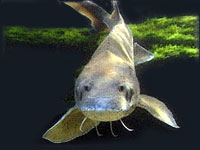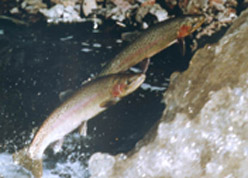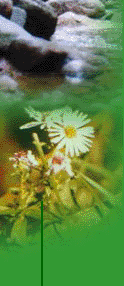|

Salmon
Salmon go through three different stages before maturity. The first stage is as an egg. The mother usually lays about 5,000 at a time. The second stage is when they've hatched, the alevin stage. While alevins, they carry yolk sacs that hold all the vital nutrients for survival. As they grow older, they lose the yolk sac. Finnally, they are fingerlings. As fingerlings, they instinctively start to head towards the ocean.
|  |

White Sturgeon
The life cycle of the white sturgeon is not very well documented. However, we do know that the sturgeon mature rapidly from birth, and spawn in swift moving water such as rivers and streams. The months in which they instinctivly spawn are May and June. They can grow as big as 6.1 m and 816 kg, and can live up to 100 years.
|
|

Pacific Lamprey
The Pacific Lamprey has no real fins, jaws, or bones. They are anadromous, just like salmon, and migrate to fresh water and spawn. The Lamprey start traveling to spawn around the months of July through October. They actually start spawning around the spring when the temperature of the water is about 50 degrees Fahrenheit. Adults usually die within four days of giving birth, after having about 70,000 small, sticky eggs in their nest.
|  |

Steelhead
Steelhead start their life cycles in fresh water, and start to migrate to ocean waters after about 1-4 years. Steelhead migrate alone, rather than together in schools like salmon. Also, unlike salmon, steelhead don't nessesarily die after spawning. They could migrate to the ocean and back as many times as their life line will allow. The time to spawn for them is either the "winter run", late fall, winter, and early spring; or the "summer run" in late spring, summer and early fall.
|




